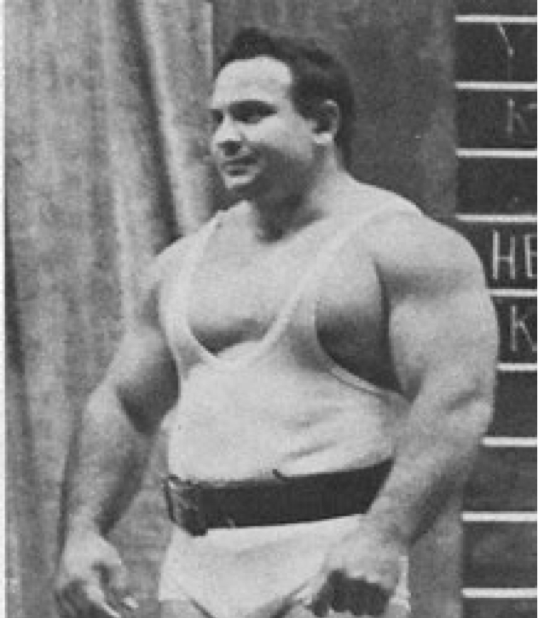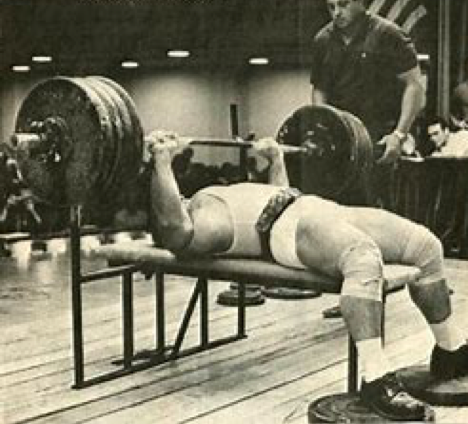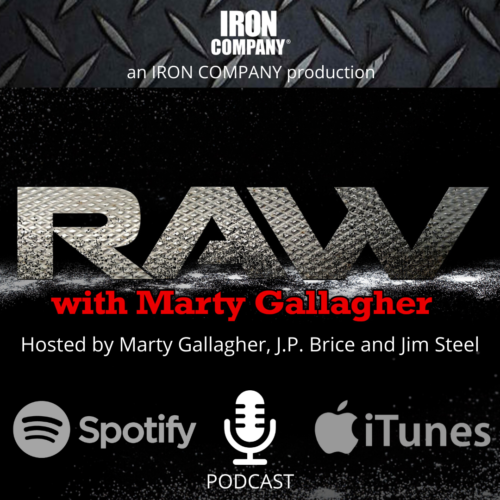
Barbell Bench Press Refresher Course
It’s the little things that matter….
Old School barbell bench press Grand Maestro Mel Hennessey, shown above circa 1966. Mel stood 5-4 and weighed 220-pounds. He is shown
readying for a 585-pound (raw) world record bench press. Mel was built to lift weights. No one trick pony, Mel also barbell squatted 800-raw.
The barbell bench press is quite likely the most popular and practiced of all progressive resistance exercises. Bench press techniques will vary as everyone has an opinion on how best to bench. I am no exception. I learned my bench press basics from a world champion and I in turn created world champions, men with 600-pound raw bench presses. Our approach uses stylistic subtleties and technical characteristics unique to our way of benching and our system of strength.
Multi-time world champion and world record holder Kirk Karwoski and I teach and coach young strength athletes every Sunday. We introduce trainees to “our style and system” of benching. We utilize the ten bullet points outlined; this is how we talk a barbell bench press newbie through their first Old School bench press session.
- Set the feet: in the barbell bench press there are four points of contact, the two feet on the floor, the glutes and the lifters upper back on the bench. Splay the feet wide and push down hard, tensing the legs and glutes. Leg and glute tension stabilize the torso during both eccentric and concentric phase. Some world class benchers set their feet under the knees, some set the feet behind the knees. Those that use leg drive to start the bench press set their feet in front of the knees and send a jolt, starting in the feet, that travels through the legs and into the torso. Regardless of the fore-aft placement of the feet, always maintain leg tension.
- Establish an arch: an overhead press is more difficult than a 45-degree incline press; a 45-degree incline press is more difficult than a flat bench press; a flat-bench is more difficult than a decline press. The reason elite bench pressers arch their spine is to turn a flat bench into a decline bench. Arching improves leverage: combine a superb arch with a maximally inflated chest and decrease the length of the rep-stroke. How to arch: establish the base, create leg and glute tension. Grasp the barbell with the grip width you intend on using. Pull your shoulder off the bench while arching the spinal column. Lower the arched spine till the shoulders touch the bench. You are now arched – stay this way for the entire set – don’t let the arch flatten as you rep.
- Pull the bar downward: beginner and intermediate bench presser will take the barbell out of the supports and allow gravity to do its work. The elite bench presser will ‘pull the bar downward,’ resisting the poundage with tensed muscles. This ‘controlled lowering’ maximizes the muscle and strength building attributes of the negative. Rather than allowing the bar to freefall and rebound off the chest (creating momentum) the topflight bencher creates coiled energy with a tight, taunt, tension-filled lowering. Regardless if you are using touch-and-go or paused reps, regardless the grip width, regardless if you are using a barbell or dumbbells, pull the bar downward with tension. Don’t throw away the muscle-building strength-infusing attributes of the bench negative.
- Elbows turned inward: the flared elbow barbell bench press was and is very popular in bodybuilding circles. Big benchers avoid flared elbows due to unreasonable strain on the shoulder joints and rotator cuffs. Elite bench pressers, men with 600-pound raw bench presses, men like Ken Fantano and Kirk Karwoski, keep the elbows tucked inward as the barbell is lowered. Kirk suggests the way to attain proper elbow position is to grasp the bar and try and rotate the wrists inward, ‘try and break the bar in half and keep trying to break it throughout the set’ – this trick of the trade establishes the proper elbow position. In the bottom position, the triceps wedge against the flexed lats to provide the perfect leverage for the launch.

Mel Hennessey was so short he needed weight plates for his feet to reach the floor: he wore street shoes squatting, benching and deadlifting. His strength was casual, everything was low-keyed and laid back, he gave the impression of always having strength in reserve – even on world record attempts he seemed just shy of yawning.
5. Touch the highest point of the inflated chest: this is a no-brainer. By maximally inhaling the chest, the rep stroke is shortened. Inhale “as if trying to suck all the air out of the room.” Inhaling becomes better with time and practice. Every additional inch of chest expansion is one less inch to have to push the barbell. The combination of arching, inhaling and using a wide grip shortens a bench press rep stroke by three to six inches. The touch point for the bar on the chest should be below the pectorals. In a properly arched barbell bench press, the pecs are not the high point, the sternum/solar plexus will protrude even higher than the pecs. When a man lays flat as a pancake to bench, his pecs are the high point.
6. Arc down, Arc back up: our school of bench pressing uses a ‘slight arc’ on both the bar descent and ascent. The bencher positions himself on the bench so that after setting the feet, after arching and setting the shoulders, the lifters eyes are directly under the barbell as it sits in the rack. The barbell is broken from the racks and lowered (with elbows turned inward) to the high point on the chest. The lifter uses a precise, tension-filled lowering, arcing downward, from over the eyes to the chest high point. It can be a pause or a touch-and-go, regardless, an identical pathway is used on the upward push. Slight arc on the way down, slight arc on the way back up. The barbell bench press is different from the squat and deadlift in that the weakest muscles, the triceps, finish the lift. By having an ‘up and back’ motor-pathway the triceps burden at lockout is lessened.
7. Pause or Touch-and-go: the turnaround occurs when descent becomes ascent, where eccentric becomes concentric. In the barbell bench press, at the bottom of the repetition the lifter can either pause the bar (or dumbbells) on the chest or use a style called touch-and-go wherein the instant the bar or bells touch the chest the bar path is reversed. Too often, the touch-and-go becomes an excuse for rebounding off the chest. This creates momentum, making the lift easier and creating a zone of no-tension, ergo weakness. This is to be avoided. The paused bench press is just that: the payload is purposefully held on the chest before being pushed upward. The ideal pause length is short: holding long pauses on the chest reduces poundage-handling ability to an unacceptable degree. Touch-and-go benching uses a controlled descent and reverses the instant the payload touches the chest.
8. Best flat bench assistance exercises? Varied grip widths: World powerlifting champion Hugh Cassidy once noted with Zen clarity, ‘the best assistance exercise is one that most closely resembles the actual lift.” Ergo, the best assistance exercises for the flat bench press is not the 45-degree incline press, not the overhead press, the best assistance exercise for flat benching is more flat benching using different grip widths. Work three grip widths: wide, narrow and ‘regular’ or power grip. The power grip is slightly wider than shoulder width and typically the strongest grip width. A wide-grip bench press stresses the pec muscles to near exclusion; a narrow grip stresses the triceps lockout. The wide grip is 2-4 inches wider than the power grip; the narrow grip is 2-4 inches narrower than the power grip. Wide-grips are usually paused; narrow-grips are done touch-and-go style.
9. Frequency: beginner and intermediate trainees and bodybuilders tend to bench press too much. The ‘beach muscles,’ those seen in the mirror, the pecs, delts, arms and abs receive too much training attention. There is no need to bench press three times a week and a strong case can be made for bench pressing once a week. Many trainees will strike a balance by doing their flat benching on one day of the week and taking a second day to work incline or overhead presses. Heavy overhead pressing, front and behind-the-neck, improves flat benching and needs to be woven into the training template. Heavy overhead pressing suffers if done after heavy benching. Give shoulders their own day. Many top benchers love the 45-degree incline press as an alternative to the standing barbell bench press.
10. Constructing a power bench routine: the classic power bench pressing routine is designed to work pecs, front and side delts and triceps. On day one, three grip widths are practiced using a combination of pauses and touch-and-go style. This is backed by arm work. On a second day, 2-3 days later, heavy shoulder presses (or incline presses) are performed along with some addition tricep/bicep work using different exercises.
Day 1
Competition grip width: power grip, work up to a top set of five reps, touch-and-go style
Wide-grip bench: drop poundage 5%, grip 2-4 inches wider than power grip, rep out, paused reps
Narrow-grip: drop another 5%, 2-4 inches narrower than power-grip, rep out, touch & go style
Weighted dips: 3-4 sets and work up to a top set of 5-6 reps, then one set to failure, no weight
Curls: 3-4 sets of whatever curl you want, super-set with dips
Day 2
Heavy barbell bench press (or 45-degree incline press) 3-5 sets, work up to a top set of five reps
Standing overhead press-behind-the-neck: work up to a top set of five reps
Williams’ front raise: stand erect, hold a plate with both hands at crotch, raise overhead, to failure
French press: while standing, push a dumbbell overhead with two hands, 3-4 sets of 5-8 reps
Curls: any type, make the mind/muscle connection, superset, i.e. alternate, curls with triceps
About the Author
As an athlete Marty Gallagher is a national and world champion in Olympic lifting and powerlifting. He was a world champion team coach in 1991 and coached Black's Gym to five national team titles. He's also coached some of the strongest men on the planet including Kirk Karwoski when he completed his world record 1,003 lb. squat. Today he teaches the US Secret Service and Tier 1 Spec Ops on how to maximize their strength in minimal time. As a writer since 1978 he’s written for Powerlifting USA, Milo, Flex Magazine, Muscle & Fitness, Prime Fitness, Washington Post, Dragon Door and now IRON COMPANY. He’s also the author of multiple books including Purposeful Primitive, Strong Medicine, Ed Coan’s book “Coan, The Man, the Myth, the Method" and numerous others. Read the Marty Gallagher biography here.



